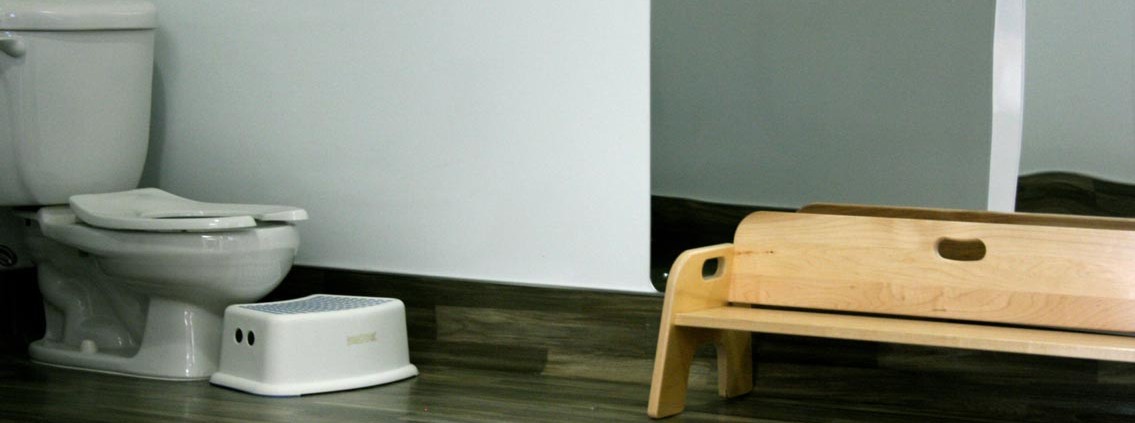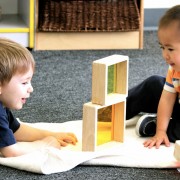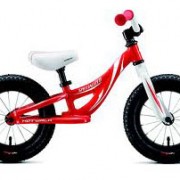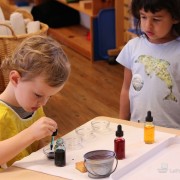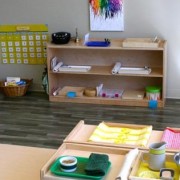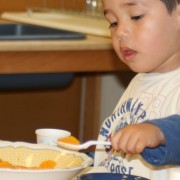Toilet Learning, not Potty Training
Potty training: Just mention this word, and many parents of toddler cringe. Numerous books have been written about the subject–including variations on potty training for boys and potty training for girls–and parents and educators hotly debate the right time and approach for children to transition out of diapers and learn to use the toilet.
At LePort, we apply Montessori principles to this important childhood task: toilet learning is an integral part of our Montessori toddler program, and, of course, included in the program at no additional charge. (We say toilet learning, not potty training, for a reason–read on, and you’ll find out why!)
-
- Toilet learning is a natural part of a child’s developing independence skill set. Being able to use the toilet without help by an adult is an important milestone to a child’s independence. In a Montessori toddler class, it’s just one natural step in all the other work on independence your child will engage in. In fact, many of the independence skills we teach him – hanging up his coat, putting on socks and shoes, learning to button and to close zippers, proper hand washing techniques – are skills that will make it much easier for him to successfully use the toilet by himself.

- A respectful focus on learning, not training. Much advice on “potty training” includes relying on rewards (stickers etc.) and punishments. These extrinsic incentives, in our view, are detrimental to any learning process, including learning how to use the toilet independently. In the Montessori toddler classrooms, your child will instead encounter the toilet as a natural part of growing up. He’ll see older peers using potty chairs or low, child-sized toilets. He’ll be invited to try sitting on the toilet, as a natural part of changing his diaper. The child’s wish to imitate his older peers, his burgeoning desire to be master of his own needs, and his interest in a consistent routine are our best allies here. And, of course, our 1:6 (or in limited cases 1:7) ratio up to age 3 enables us to spend more time teaching than in other programs, where the ratio of staff to children sometimes changes to 1:12 at age two, long before most children have completed the toilet learning process!
- Toilet learning is a natural part of a child’s developing independence skill set. Being able to use the toilet without help by an adult is an important milestone to a child’s independence. In a Montessori toddler class, it’s just one natural step in all the other work on independence your child will engage in. In fact, many of the independence skills we teach him – hanging up his coat, putting on socks and shoes, learning to button and to close zippers, proper hand washing techniques – are skills that will make it much easier for him to successfully use the toilet by himself.
-
- An early start to learning. In a Montessori infant or toddler daycare setting, toilet learning starts early. When we diaper babies in our infant daycare rooms, we do so in the bathroom, to begin associating elimination processes with the appropriate location. We invite them to help: to lift up their legs, to climb up on the low changing table, to pull open diaper tabs. Once a child is able to stand up steadily, we start changing his diaper while he is standing up. We also invite him to sit on the potty, sometimes for children just barely over a year old. We never force a child to sit on the toilet or otherwise rush the process of toilet learning– but often, they become interested in these activities the same way they become interested in other things older children or adults do!
- An encouraging follow-the-child approach. Montessori teachers are careful observers, introducing activities to children whom they judge to be developmentally ready. The same is true for toilet learning: while we encourage participation in the process from day one, our teachers watch for signs of readiness to start a more intensive, “official” toilet learning phase. Readiness, in this context, does not mean a child who declares, “I want to use the toilet and wear diapers” (although some 2-year-olds have been known to say just that!) “Potty training” readiness means a child who has mastered prerequisite skills (e.g., who has a dry diaper for longer periods between changes, who can pull his own pants down and back up) and who shows an interest in becoming more independent and/or in using the toilet (observing other children, asking questions, being interested in flushing, talking about bodily functions.) Once we identify a child as ready, we begin to work together with you, the parents, and switch from diapers to cotton underpants.
- A joint school-parent effort. In order to help your child be successful at toilet learning, we work closely with you to identify the right time, and to put in place a consistent approach at home and in the school. For example, once your child starts, we want him to be in cotton underpants (no pull-ups!) for all his waking hours, at school and at home. Since some “wet events” early in the process are unavoidable, we work with you to start the process at a time when you can dedicate your attention to it at home, too. We provide detailed, written tips that we encourage you to follow, from the language to use (e.g., saying “Let’s use the toilet now that you are awake”, rather than asking “Would you like to use the toilet”, which invites a reflexive no from many toddlers!), to advice on clothing to wear, and common mistakes to avoid in the process. Every year, we also host one or several Parent Info Evening dedicated to potty training, where you can get your questions answered by your child’s teachers.
We have found that toilet learning the Montessori way is often much easier than parents expect when they first approach the “potty training” process. When parents and school work closely together, a child can easily complete toilet learning well before the age of three, the time the child transitions to the primary classroom, which requires him to be fully independent in the use of the toilet.

